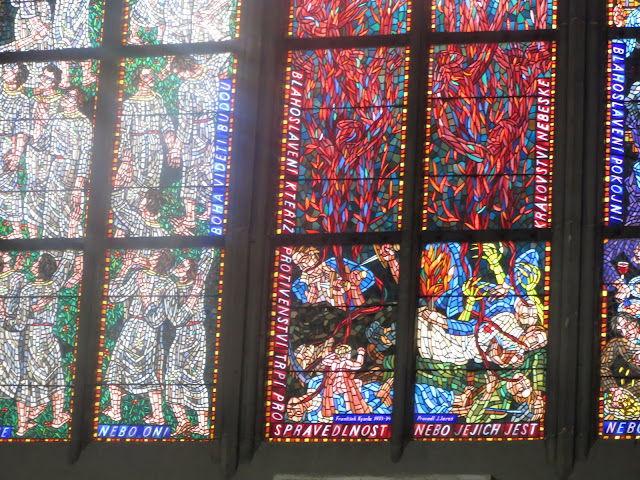Here we are with Judy and Bob in front of St. Barbara's Cathedral at Kutna Hora. It was built by funds from local silver miners starting in the late 1300s. It wasn't actually finished until 1906. St. Barbara is the patron saint of miners. Notice the great flying buttresses-those "wings" coming out from the side of the building, and architectural feature which "resist(s) the lateral forces pushing a wall outwards" according to Wikipedia.
This cathedral has beautiful stained glass windows, many of which have mining themes.
Every cathedral has one of these elaborate places from which the priest would stand and speak. The "roof" was meant to represent the hand of God.
Picture of the soaring ceiling.
We climbed to the top of the old clock tower to see this beautiful city view...
...and a shot looking down.
I love this statue of Kafka by Jaroslav Rona, meant to illustrate Kafka on the shoulders of an empty suite where he can see the city from a different perspective.
This is the striking Spanish Jewish Synagogue.
Virtually every synagogue in this area was destroyed in World War II, but this particular one was taken over by Nazis and used as a headquarters and storage facility.
This synagogue was built in the 1860s and with its heavy Spanish style influence, was one of the most beautiful buildings of worship we visited.
Nearby is the Jewish cemetery The oldest headstone dates from 1439. Today the cemetery contains more than 12,000 tombstones, although many, many more people are buried here. There are several layers of buried people. When they ran out of space, they simple but down a few layers of earth and resumed burying.
Jubilee Synagogue. Yep, it's got pink stripes.
Built in 1905, it's the newest synagogue in Prague.
The synagogue blends Art Nouveau and Moorish Revival styles.
Although open to the public, it's still used as a house of worship.
Stan, wearing a kippa, required of all men entering the synagogue.
My Hebrew is a bit rusty, but I'm guessing these are the ten commandments.
View from the second floor.
Somewhere along the way, we slipped into a Hussite church during a service.
The woman leading the service was singing
and even though she sang in Czech,
it was absolutely beautiful.
Final section- I promise. We visited the Prague Castle--largest castle in the world.
It dates back to the year 870 (!).
It comes with its own guards
and a magnificent church.
Not to mention patrol gunners, looking for troublemakers (run, Stan!!!).
St. Vitus cathedral, built on the castle grounds, is heavy Gothic style.
Love these gargoyles, meant to convince the devil and his minions that this building was already bedeviled. Those two men in suits behind the head of the lower gargoyle are the architects, who worked themselves into the building designs to give themselves credit.
Construction of this church began in 1060, but like all churches in Europe, was changed, damaged in wars, rebuilt, added to, and renovated for centuries.
BEEE UUU tiful stained glass.
The names around the glass are those who donated to their creation.
I'm thinking of replacing my living room window.
Don't mess with this guy.
This church contains tombs of kings and emperors.
Judy: "Hey, what's Captain Moroni doing in here???"
Inside the castle: A ceramic oven for heating the castle.
The main hall where jousting matches were held.
Well, I have at least a million more pictures
and a million more stories of Prague,
but all things must come to an end
so we're off to Vienna.






















































Hmmm, that last picture reminds me that we should have taken the taxi like Bob said. It's hard to do this city justice, isn't it? I'm way behind you. I've got my first post on Prague just about ready to go up. Maybe I should just post a link to your blog.
ReplyDeleteNice memories. Stan looks good with his little hat and has a nice skip as well.
ReplyDelete